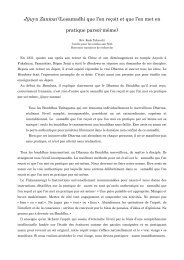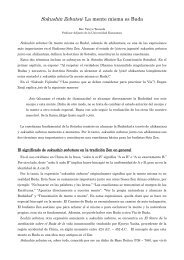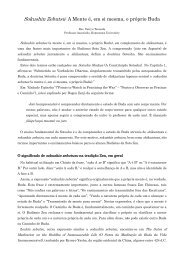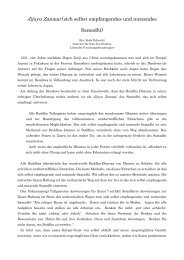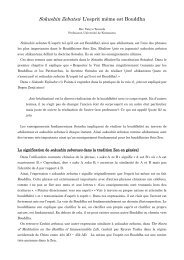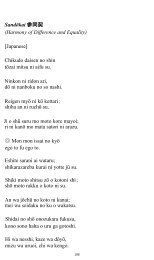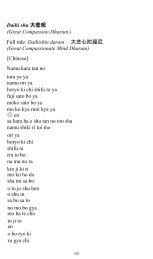Sokushin Zebutsu - sotozen-net
Sokushin Zebutsu - sotozen-net
Sokushin Zebutsu - sotozen-net
Create successful ePaper yourself
Turn your PDF publications into a flip-book with our unique Google optimized e-Paper software.
<strong>Sokushin</strong> <strong>Zebutsu</strong>: The Mind Itself is BuddhaRev. Tairyu TsunodaAssociate professor, Komazawa University<strong>Sokushin</strong> zebutsu (the mind itself is Buddha), in addition to shikantaza, is one of the mostimportant phrases in Soto Zen Buddhism. Realizing (joto in Japanese) sokushin zebutsu togetherwith shikantaza, defines Sotoshu doctrine. They are its ultimate teaching.These two terms are even emphasized in the Sotoshu Shuken (The Sotoshu Constitution). InChapter One it states “Abiding by the True Dharma singularly transmitted by theBuddha-ancestors, the Sotoshu doctrine is to realize (joto) shikantaza (just sitting) and sokushinzebutsu (the mind itself is Buddha).”In “Gakudo Yojinshu” (“Points to Watch in Practicing the Way”), joto is explained by Dogen Zenjias follows:Joto (realizing) is to directly realize Buddhahood with this body-mind. In other words, it isnot to change the former state of body-mind into some other special state but just to follow therealization of the other (one’s teacher). It is called jikige (right here) or joto.The fundamental Sotoshu teaching is that of realizing Buddhahood through shikantaza andsokushin zebutsu in each moment. Therefore sokushin zebutsu, as well as shikantaza, is a veryimportant term and a basic teaching for Soto Zen Buddhists.The meaning of sokushin zebutusu in Zen tradition in generalIn the customary Chinese usage of the phrase, “soku A ze B” means “A is B” or “A is exactly B.”On the other hand, to say “soku A soku B,” is to emphasize the sameness of A and B but not theidentity of A with B.So, the expression “sokushin zebutsu” originally means that the mind itself is actually Buddha.This phrase is highly important along with other famous Chinese Zen phrases, such as “Not relyingon words and letters.” “Teachings are transmitted outside the Scriptures.” “Pointing directly toone's mind.” “Seeing into one’s own nature and attaining Buddhahood.” and “Mind to mindtransmission.” In these expressions, it is clear that mind is strongly emphasized. The BuddhaWay is fundamentally a path of self-inquiry. Zen Buddhism claims that to clarify the self, or toclarify one’s own mind and one’s own nature, is fundamental. Besides that, there can be no otherBuddha or Buddha Way.Zeshin zebutsu, another expression similar to sokushin zebutsu, is found in The Sutra ofMeditation on the Buddha of Immeasurable Life, translated by Kyoryo Yasha of the western regionof China sometime between 424 AD ~ 452 AD. The notion this mind is Buddha is a very old one inZen.
More than anything else, sokushin zebutsu is famous as a saying of Baso Doitsu (709 ~ 788), wholived in the Tang Dynasty.<strong>Sokushin</strong> zebutsu and shikantazaDogen Zenji tells about Baso Doitsu’s sokushin zebutsu or sokushin sokubutsu in a jodo (talk) inthe Eihei Koroku.Baso said “<strong>Sokushin</strong> zebutsu.” Daibai studied this more than thirty years, dwelling on hismountaintop, hiding his traces in the sounds of the valley and the colors of the mountain. Theancestor Baso finally sent a monk to visit and say to Daibai, “Baso’s Buddha Dharma isdifferent these days.”Daibai responded, “How is it different?”The monk said, “Hishin hibutsu.” (no mind, no Buddha).Daibai said “Even if he says ‘No mind, no Buddha,’ I just follow sokushin zebutsu.”The monk returned and told the ancestor.Baso said, “That plum is ripe.”Dogen said “<strong>Sokushin</strong> zebutsu is most intimate. Year after year Daibai ripened in themiddle of summer.” (Eihei Koroku, vol. 1, no. 8)Daibai Hojo (752~839) understood the Buddha Way through the teaching of Baso’s sokushinzebutsu and retreated into the deep mountains for more than thirty years. He wholeheartedlypracticed sokushin zebutsu. He was not at all upset when a monk dispatched by Baso said, “Baso’sBuddha Dharma has recently changed from sokushin zebutsu to hishin hibutsu.” He said, “I do notcare about hishin hibutsu. I just follow solely sokushin zebutsu.” Upon hearing this statement, Basoadmired Daibai, saying, “A plum has ripened.”This episode featuring Daibai and Baso also appears in Eihei Koroku, vol. 4, no. 319. Interestingly,this jodo begins with the statement “The true Dharma correctly transmitted by buddhas andancestors is simply shikantaza.” Dogen introduces this statement as his late master Nyojo’sinstruction to the assembly. Here, the story is told in order to emphasize the importance of zazen(shikantaza). Dogen Zenji speaks of Daibai as a person who “ate pine nuts and wore lotus leaves,spending his whole life practicing zazen day and night.” The story is originally found in the “DaibaiHojo” chapter in the Record of the Transmission of the Lamp Published in the Jingde Era (KeitokuDentoroku, Taisho Tripitaka 51, p. 254 ff.). This source does not mention that Daibai practicedzazen in the mountains. Probably “spending his whole life practicing zazen” is Dogen’s personalreligious conviction. “I just follow sokushin sokubutsu” means nothing but shikantaza. Therefore itis not without reason that this phrase is paired with shikantaza in Sotoshu Shuken (Soto ShuConstitution).It is understandable that Dogen Zenji writes at the beginning of Shobogenzo “<strong>Sokushin</strong> <strong>Zebutsu</strong>,”“What buddhas and ancestors have maintained without exception is sokushin zebutsu.” It is suchan important phrase describing realization that it is perfectly all right to replace sokushin zebutsu
with zazen.Dogen Zenji says “<strong>Sokushin</strong> zebutsu is buddhas of aspiration, practice, awakening, andnirvana.”In Shobogenzo “<strong>Sokushin</strong> <strong>Zebutsu</strong>,” Dogen Zenji writes “Upon hearing the phrase ‘sokushinzebutsu,’ ignorant people think that the thoughts and awareness of sentient beings, although theyhave not aroused the aspiration for awakening, are already buddha. They think in this way becausethey have not yet met an authentic teacher.”When ignorant people hear Baso’s well-known phrase, they erroneously think that the ordinarymind of thinking and awareness, the mind before arousing bodhicitta (aspiration for awakening), isunconditionally already Buddha. Dogen admonishes that it is because they have never met anauthentic teacher.Then what is sokushin zebutsu? Dogen writes “<strong>Sokushin</strong> zebutsu is buddhas of aspiration,practice, awakening, and nirvana. Those who have not actualized aspiration, practice, awakening,and nirvana are not sokushin zebutsu.”Usually “aspiration, practice, awakening and nirvana” are thought of as four stages of Buddhisttraining. “Aspiration” is an abbreviation of “aspiration for Bodhi (awakening).” It means to arousethe mind that seeks for the Buddha Way. After aspiration, we move to the stage of practice.“Practice” is an abbreviation of “long-term training with diligence.” As a result of practice, we attainawakening. “Awakening” means to accomplish the Way. With this we enter into nirvana. “Nirvana”means eradication of all defilements. It is a state of attaining complete awakening. There are twokinds of nirvana; nirvana with remainder and nirvana with no residue. Nirvana with remainder isthe nirvana of an awakened person who has eradicated all the defilements but is still alive with abody. Nirvana with no residue is the nirvana of an awakened person who has died and thuseradicated both the body and all defilements. Because of the idea of nirvana with no residue, thedeath of the Buddha is sometimes called nirvana.Therefore, the general understanding of aspiration, practice, awakening, and nirvana is that theyare four sequential stages. Aspiration comes first. After aspiration, practice begins. As a result ofpractice, awakening is accomplished. Then, the awakened person enters the state of nirvana withremainder. When the body dies, the awakened person finally enters nirvana with no residue.However, Dogen Zenji writes in Shobogenzo “Gyoji: Part One” “Between aspiration, practice,awakening and nirvana, there is not a moment’s gap.” There should be no interval or gap betweenthose four. It should be aspirationpracticeawakeningnirvana. Where aspiration is present, there isalready practice. Practice is itself awakening (identity of practice and realization). Thispractice-awakening is nirvana. Thus “aspiration, practice, awakening, and nirvana” are notsequential stages. All are one. Buddhas are practicing this oneness of “aspiration, practice,awakening, and nirvana.” That is exactly what sokushin zebutsu is all about.Shakyamuni Buddha is sokushin zebutsu
At the end of Shobogenzo “<strong>Sokushin</strong> <strong>Zebutsu</strong>,” Dogen Zenji emphasizes that “The buddhas spokenof here are none other than Shakayamuni Buddha. Shakyamuni Buddha is sokushin zebutsu.When all buddhas in the past, present, and future are buddhas, they unfailingly becomeShakyamuni Buddha.”Here he teaches that sokushin zebutsu is Shakyamuni Buddha. All buddhas who practiceaspiration, practice, awakening, and nirvana are Shakyamuni Buddha himself. Dogen Zenjideclares that Shakyamuni Buddha is sokushin zebutsu.Therefore for Dogen Zenji, sokushin zebutsu changes its meaning drastically from “The minditself is Buddha” to “Buddha called sokushin zebutsu” or “Buddha of aspiration, practice,awakening, and nirvana.” This Buddha is not something far away from us. We ourselves should bea Buddha called sokushin zebutsu.Originally written in Japanese by Rev. Tairyu TsunodaTranslated by Rev. Issho FujitaAssisted by Rev. Tonen O'Connor and Rev. Zuiko Redding


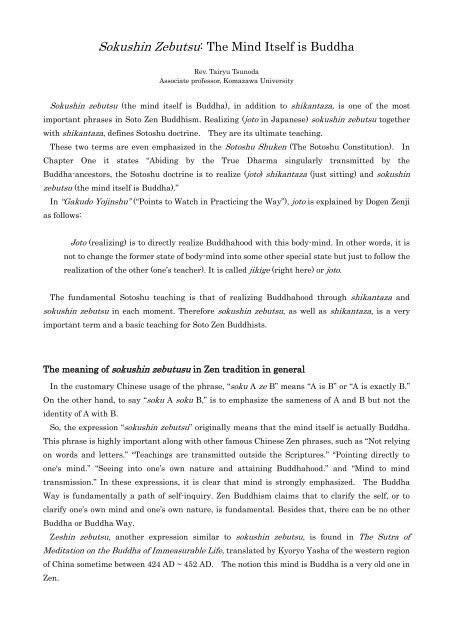
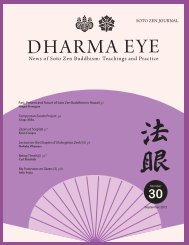

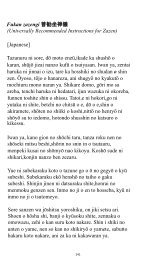

![(Daihishin darani 大æ²å¿éç¾
å°¼ï¼ [Chinese] - sotozen-net](https://img.yumpu.com/38648887/1/156x260/daihishin-darani-aaeaec-3-4-a-1-4-i-1-4-chinese-sotozen-net.jpg?quality=85)


